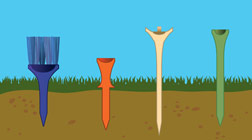
A lot of types of golf tees have been designed and patented, even though not all have been commercialized. Ordinary tees are made from wood or plastic. A recent development are biodegradable tees, which biodegrade in about a year in an active, organic environment, and thus help protect the golf course ecosystem. They also last about twice (or more) the number of drives per tee as compared to wooden tees, thus reducing tee box litter. The concept is similar to biodegradable golf balls that biodegrade in water.
Recent developments in golf tees have been basically oriented towards one of two scopes: either offering a consistent ball height on the tee or offering less resistance with the aim to provide a longer and faster ball flight with less backspin.
The first type of tees are designed in such a way that they can not be inserted below a certain predetermined point under the top for more consistent ball height on tee shots.
Some new golf tees have a slight adjustment with the holster for the ball, better known as zero friction, stinger tees or more trajectory tees. Zero friction tees generally have a tri-holster, which some people find hard to balance the ball on. Due to a reduced friction top zero friction tees provide significantly less resistance than a traditional golf tee. These tees are also said to provide almost 5 yards over any other “performance” golf tee thanks to the reduced spin rate. In stinger tees the thinner head and shaft, and shallower cup create less resistance and less drag than the bulkier, regular tee.
Aero Spark tees have a flexible neck which makes the tee difficult to break. The also last longer than conventional tees (more than 3 rounds on average).
See also:
Golf tees (definition, use, regulations)
All-time favorite golf balls
More golf balls
External links:
Biodegradable tees

